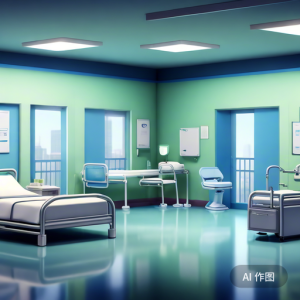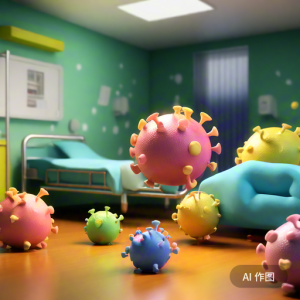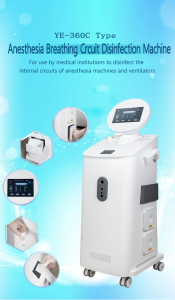01Concept
Terminal disinfection of wards is a crucial part of hospital infection control. It refers to a comprehensive and thorough disinfection process of the ward and all potentially contaminated items and air in it after the patient is discharged, transferred or dies. This process aims to eliminate all kinds of pathogenic microorganisms left by the patient, ensure the harmlessness of the ward environment, and thus reduce the potential infection risk to other patients and medical staff.
 02Disinfection Method
02Disinfection Method
picture
Air disinfection: Commonly used air disinfection methods include centralized air conditioning and ventilation systems, ultraviolet disinfection, electrostatic adsorption air sterilizers, ozone disinfection, and hydrogen peroxide atomization disinfection. Atomized hydrogen peroxide is generally used for disinfection. Hydrogen peroxide has the advantages of being less irritating to the human body, less corrosive, easy to vaporize, and leaving no toxic substances. It is widely used in the environmental disinfection of wards and ICUs, and the effect is remarkable.
picture
Disinfection of object surfaces: Object surfaces are one of the main habitats for pathogens, including diagnosis and treatment facilities, equipment surfaces, and high-frequency contact surfaces, such as bed rails, bedside tables, call buttons, monitors, micropumps, door handles, etc. When disinfecting, disinfectant wipes or cloth soaked in disinfectant should be used first to wipe to ensure that there are no omissions or dead corners on the surface.
picture
Floor Disinfection: The floor is one of the most contaminated and difficult to clean areas in the ward. When disinfecting, high-efficiency disinfectants such as chlorine-containing disinfectant or hydrogen peroxide should be used to mop the floor from the inside to the outside in an "S" or "Z" pattern.
picture
Disinfection of medical devices: Medical devices are extremely susceptible to contamination during use, so they must undergo strict disinfection. Common disinfection methods include high-temperature steam disinfection, chemical disinfectant soaking, etc.
03Main problems in the disinfection process
Picture
Low surface removal rate: less than 50% of surface pollution is removed, and the cleaning staff operates arbitrarily, resulting in incomplete cleaning of high-frequency contact surfaces such as instruments and treatment tables.
Picture
Air disinfection problems: There are blind spots in ultraviolet disinfection, improper operation (such as turning on when people are present, lamps not maintained) and improper use of air disinfection machines (such as not closing windows, damaged lamps not replaced), which affect the disinfection effect.
Picture
Low tool replacement frequency: cleaning tools such as rags and mops are not replaced in time, and there is a risk of cross-contamination.
Picture
Insufficient wiping order and time: The disinfection order is unreasonable, and the disinfection time after cleaning does not meet the specified standards, affecting the disinfection effect. Cleaning and disinfection should be carried out in an orderly manner, from top to bottom, from inside to outside, from light pollution to heavy pollution. When multiple patients live together, the cleaning unit operation should be followed.
Picture
Blind spots in bedding cleaning: Indirect contact items such as quilt cores and pillow cores are not cleaned and disinfected enough, becoming a potential source of infection.
 04A good helper for terminal disinfection of wards
04A good helper for terminal disinfection of wards
YE-5F hydrogen peroxide compound factor disinfection machine
Combined killing of five disinfection factors: YE-5F disinfection machine integrates five disinfection factors of hydrogen peroxide, ozone, ultraviolet light, photocatalyst and coarse filter. Through the combination of active disinfection and passive disinfection, it can effectively disinfect the space. Multi-directional, three-dimensional, surrounding and cyclic killing of air and object surfaces. This composite disinfection method significantly improves disinfection efficiency and effectiveness.
Supports coexistence of humans and machines: The disinfection machine supports the coexistence of humans and machines, that is, no personnel are required to evacuate during the disinfection process, thus avoiding interruption of medical activities due to disinfection. This is especially important for places like hospitals that need to continue to function.
Efficient sterilization: After hydrogen peroxide changes from liquid to gaseous state, its sterilization intensity increases by nearly 200 times. This allows the YE-5F disinfection machine to quickly and effectively kill bacteria and viruses in the air, including multi-drug-resistant bacteria and other difficult-to-treat pathogens.
Intelligent control: The disinfection machine is equipped with an intelligent control system, which can automatically complete the disinfection process according to the preset program.
Compared with traditional disinfection methods, this disinfection machine is not only easy to operate and fast in disinfection, but also has no residue, no corrosion, and is friendly to equipment and the environment, greatly reducing the workload of medical staff.
05Overview
Terminal disinfection of wards is an indispensable part of hospital infection control, and the YE-5F hydrogen peroxide compound factor disinfector has become a good helper for terminal disinfection of wards with its efficient and accurate disinfection effect. In future medical work, with the continuous development of science and technology, we have reason to believe that more high-tech products like YE-5F will be used in the field of hospital disinfection to protect the health of patients.